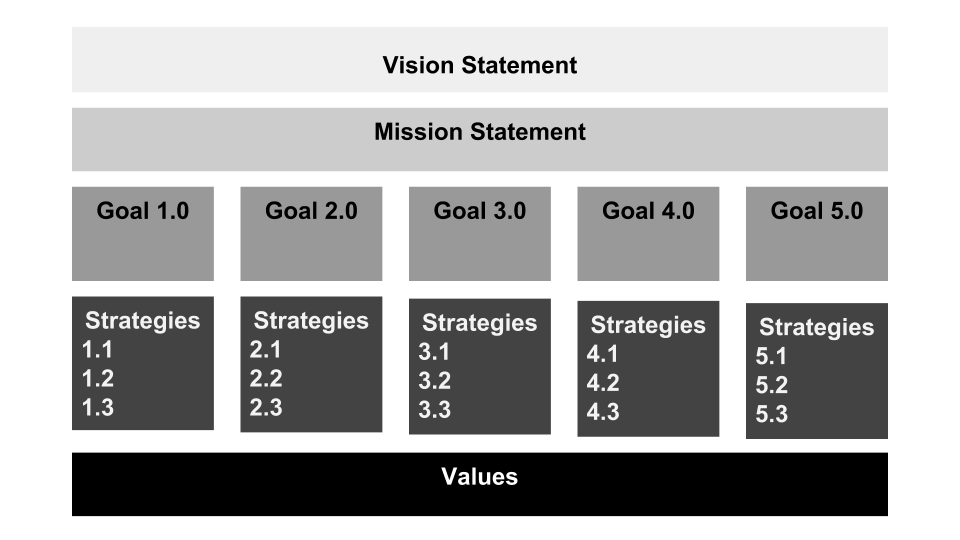A Periodic Table of Meetings (with Free Download)
In the month since we published a taxonomy of the 16 Types of Business Meetings, we’ve heard from many people who say it’s given them a useful new perspective on how to approach their meetings. We’ve also been asked many times about the chart featured in that post, which has since been shared on social media over a thousand times.
(Admittedly, not as hot as a Beyoncé snapshot, but c’mon! This is a taxonomy of meeting types we’re talking about here.)
The original post is very long and details the process we used to define each type.
Missed the original? If you have an hour, go read it now! Otherwise, here are the high points:
- A meeting is not a meeting. If you want to run better meetings, you need to know the best way to run the kind of meetings you need to run. Generic best practices won’t cut it.
- You can tell that one meeting is different from another based on these characteristics:
- the intention, or purpose and desired outcomes,
- the meeting format,
- and the expected participation profile, or, who normally runs and who normally attends these kind of meetings.
- We organized and sorted and grouped and examined every kind of meeting we could find, and narrowed them all down to 16 distinct types of meetings.
Throughout that process, we knew that there were important relationships between different kinds of meetings, and that exploring these relationships added yet another layer of usefulness to the taxonomy. When you understand not just the types, but also the relationships between meeting types, it gets much easier to answer the key question: Is this meeting the meeting we need?
So—the day before publishing the original blog post—we sat down and tried pull together the pattern. The result is the chart you see here:

“It’s like a periodic table of meetings, isn’t it?”
Wow, I wish. I’ve been asked this exact question at least 10 times, and I admit we were aiming for something along those lines. When push came to shove, though, we couldn’t find a way to divine the relative atomic weights of a One-on-One or a Decision Making Meeting. This chart isn’t quite that orderly.
That said, there are a few organizing principles at work here.
I’m going to explain the patterns in the chart with this caveat: there’s room for improvement, the chart will probably change in the future, and your advice on the matter would be most appreciated.
The Rows
The rows group meetings with similar design characteristics. All the meetings in a row share a common perspective on the organization’s work and involve people in similar ways. In the original post, these were the three major subgroups in the taxonomy.
The Cadence Meetings

These meetings involve existing groups executing on known work. They maintain and shape the organization’s current state.
These meetings reveal the organization’s reality.
Note: I’ve also been told the icons blow chunks. Designer friends, I’m open to your better ideas!
Most Cadence meetings involve some form of information sharing, problem solving, and decision making; the traditional break-down of meeting types. But these are NOT dedicated decision making meetings (for example).
Psychologically, these meetings struggle to balance accountability and camaraderie. Because the Cadence meetings must balance accountability and camaraderie, and because they often have multiple desired outcomes (updates, decisions, etc.), they’re harder to run well.
To succeed, these meetings need the right timing and framing. The language used to name these meetings matters a lot.
The Catalyst Meetings

These meetings seek to create change in the organization.
What happens in these meetings reveals who the organization thinks it should be.
A meeting dedicated entirely to solving a problem or making a decision elevates the importance of those decisions. Because these are special events, it becomes possible to use techniques that lead to better outcomes but would be awkward in a Cadence meeting.
To succeed, these meetings need the right structure.
Psychologically, these meetings struggle to balance several competing values. Do we push towards increased stability or embrace change? How do we get to an answer that’s “Good” and “Done”? There’s a tension between getting the best result and reaching a result that can quickly be put to use.
Meetings to Explore and Influence
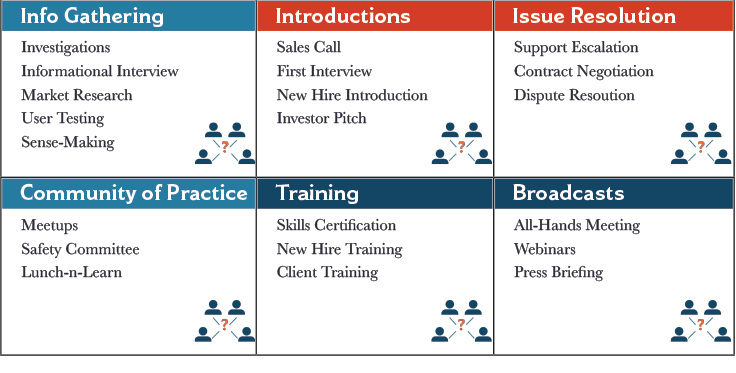
These meetings seek to learn, understand and influence the organization’s context.
These meetings reveal the organization’s values.
To succeed, these meetings need to be approached with the right mindset.
Psychologically, these meetings struggle to balance openness and confidence. True learning and negotiation requires an admission of ignorance that’s hard to balance with the need to impress and control.
The Colors
Moving from the left to the right of the chart, the heading colors shift from a lighter blue to a darker blue. A handful of the meetings have red headings.
The colors convey the emotional tenor common to those kinds of meetings.
The lighter blue meetings tend to be congenial. Relatively friendly and non-threatening.
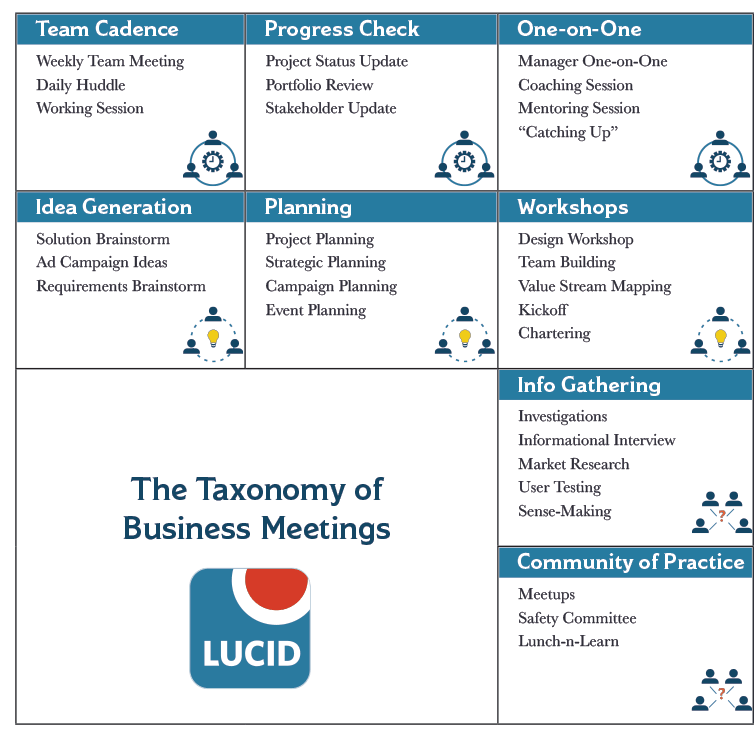
(Side note: when you see a team meeting that is not congenial— where people look like they’re headed to an inquisition or tempers flare openly, or where everyone shuffles in and out listlessly—something is very wrong in that team.)
The darker blue meetings tend to be more formal. They may still be friendly, but they require more social effort.
By way of example (and a bit of oversharing) my husband and I enjoy swashbuckling and salty language, and sometimes a bit of that spirit leaks out when we’re in a light-blue meeting. For the dark blue meetings, we stow our pirate selves below decks.

The red meetings can be intense. These are often meetings with high-stakes outcomes and include what the social scientists call “high-stakes social evaluations”; too heavy on the cortisol to be healthy every day fare.
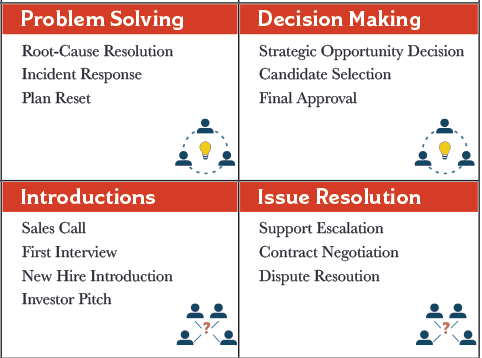
Clues to an Organization’s Meeting Performance Maturity
One final layer: you can get a feel for an organization’s scope and performance maturity by counting which kind of meetings they run and seeing how clearly they recognize the distinctions between these meetings. Very young/immature organizations “just meet”. Mature organizations develop and refine structures to improve outcomes in each scenario.
Here the pattern isn’t as clean, unfortunately. I was hoping to come up with something that worked like a game of meeting performance maturity bingo; mark off all the meetings in a section and you are a maturity level 3 winner!
It didn’t work out that way. Instead, it looks more like this.
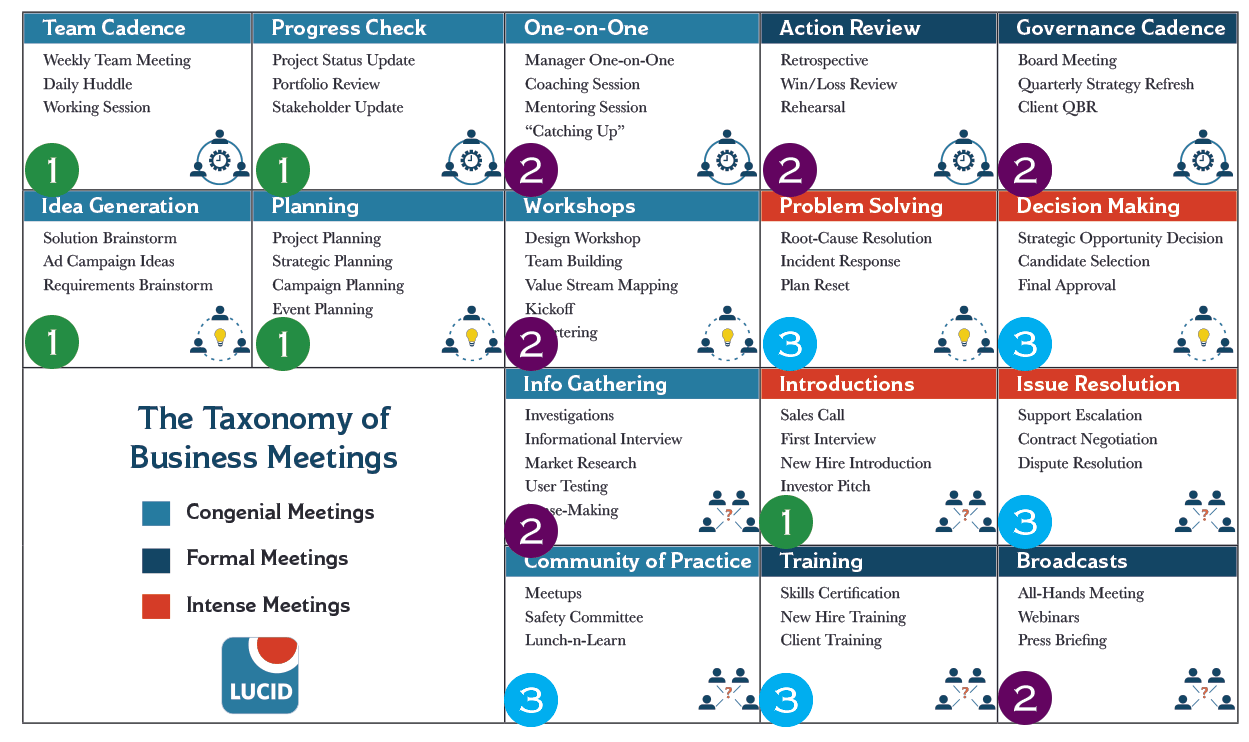
- Most organizations run the meetings in the top-left corner (team cadence, progress checks, etc.), and introductions.
- As an organization gets bigger and more complicated, they start adding more kinds of meetings. For example, one-on-ones don’t become “a thing” the organization does until they have a management layer. Once you get to that 10-20+ size, though, other kinds of meetings become inevitable.
This doesn’t mean that they run all these meetings well, or with clear intention. It’s very possible to run many different kinds of meetings with Level 2 maturity. - More mature organizations have processes for most of the different meeting types and they treat each as specialized meetings. If you schedule a problem solving or community of practice meeting, and you KNOW that you’re doing that, there’s a good chance you’ve taken some time to figure out how to make that kind of discussion work. If you run a decision making meeting, and the people you invite know what to expect from a dedicated decision-making meeting, you’re operating at a higher level of meeting performance maturity than most organizations.
By contrast, less mature organizations try to get the outcomes of a problem solving or community of practice meeting in a regularly scheduled Cadence meeting. Or by just “meeting about that thing”. This isn’t particularly effective.
Let’s keep slicing through these layers
Shrek: For your information, there’s a lot more to ogres (Meetings!) than people think.
Donkey: Example?
Shrek: Example… uh… ogres (and MEETINGS!) are like onions!
Donkey: They stink?
Shrek: Yes… No!
Donkey: Oh, they make you cry?
Shrek: No!
Donkey: Oh, you leave ’em out in the sun, they get all brown, start sproutin’ little white hairs…
Shrek: NO! Layers. Onions have layers. Ogres (Meetings!) have layers… You get it? We both have layers.
Donkey: Oh, you both have LAYERS. Oh. You know, not everybody like onions. CAKE! Everybody loves cake! Cakes have layers!
Shrek: I don’t care what everyone likes! Ogres/meetings are not like cakes.
Donkey: You know what ELSE everybody likes? Parfaits! Have you ever met a person, you say, “Let’s get some parfait,” they say, “Hell no, I don’t like no parfait.”? Parfaits are delicious!
Shrek: NO! You dense, irritating, miniature beast of burden! Ogres and meetings are like onions! End of story! Bye-bye! See ya later.
Donkey: Parfaits may be the most delicious thing on the whole damn planet!modified dialogue from Shrek
You know what? I have a 5-year-old daughter who will put all the extra onions on her plate, because I know how to cook an onion so it tastes like candy. Maybe not quite as tasty as parfait, but pretty darn tasty.
Meetings are like onions. There are layers to this stuff, and if you don’t treat it right, you will make people cry. And yet, if you cook at all, you know there are onions in everything. Just like every single organization is full of meetings.
We’ll keep peeling back these layers to figure out how to help everyone turn all the crying over meetings into frizzled shallots and bloomin’ onion awesomeness. Please share your ideas, techniques, and feedback in the comments below.
To get a copy of the full taxonomy of business meetings chart, learn about the relationships between the meeting types, and get examples of which meetings fit into each type, download the file below:


